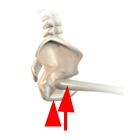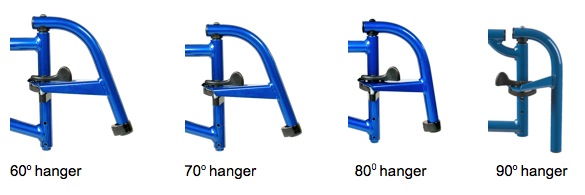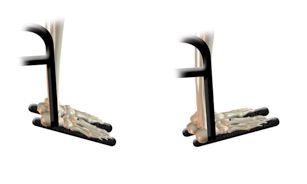Share:
Hello all!
In my last article, I wrote about some of the common equipment and musculo-skeletal factors that influence the potential for sliding while seated in a wheelchair. This month, I will discuss how features of generic seating and wheelchair configuration may assist in preventing sliding, depending upon the person's clinical presentation. Considerations for seating contour, correct angles, and gravity and how they may assist in preventing sliding will be discussed.
Let's assume that we have done the hands on assessment with the client and we understand the client's presenting posture and the need to accommodate for any fixed deformities. We are now ready to begin looking at seating considerations.

Contours in seating will help to prevent sliding for some individuals. A contoured cushion with a posterior well will help to hold the pelvis in position. If the well of the cushion is of sufficient length and depth, the well helps to anchor the pelvis in position. It works because of the difference in height between the ischial tuberosities and the femurs when in a seated position (see left). Pressure relieving material within the well of the cushion, such as air or fluid, helps to protect the ischial tuberosities and sacrum from skin breakdown, while a firmer surface may support the femurs to provide stability.
Contours in a back support (think of wedges or shapes between the foam of the back support and the aluminum shell to fit the shape of a person's back) also help to secure the body in an optimal position. By positioning a person correctly, we minimize the risk of sliding as we optimize comfort, while also ensuring better pressure distribution.
We also can consider cushion and cover materials as part of the solution to prevent sliding. Materials that tend to reduce shear forces are fluid, gel, and air, whereas there is greater friction with materials such as foam. A four-way stretch cover has less friction than a microclimatic cover. Also consider the material of the garment the person is wearing. Is there sufficient friction between the materials to assist in preventing sliding? Material alone will not prevent sliding and consideration must be given to other factors in selecting cushion and cover materials, such as ability to immerse into the cushion, in order to select the most appropriate seating solution.
We also need to think about angles. If a person is unable to achieve 90 degrees of hip flexion, the seating and mobility system should not be configured to 90 degrees. The wheelchair configuration or the seating system must accommodate for any limitations with respect to hip range of motion. How do we open up the hip angle if a person is unable to tolerate being positioned at 90 degrees? We could do it either through the configuration of the wheelchair, such as by having the back canes set to a static recline angle, or through the seating. For seating, we can open up the hip angle either through the hardware on the back support or through the cushion. With a cushion, for example, we can modify the cushion with an anterior slope to open up the hip angles bilaterally or with a trough cut-out to accommodate a unilateral hip extension contracture. Sometimes a combination of seating and wheelchair configuration is employed to achieve the required angles for an individual.
The selection of the angle for the front rigging is another important piece to ensure proper positioning and to minimize the risk of sliding. If a person has range of motion limitations in the knee or tight hamstrings, a tighter front rigging angle should be considered. Perhaps 90 degree hangers are required to allow the person to sit comfortably and to prevent sliding. Perhaps contracture rigging that allows one or both feet to be positioned under the wheelchair to accommodate for significantly reduced range of motion is required. Below are pictures of 60, 70, 80, and 90 degree hangers to illustrate the differences in hanger angles. Select the correct hanger angle to allow the person to be properly positioned and comfortable.

The position of the feet is equally important. Think about angle adjustable foot plates and ensuring the correct angle to allow for proper loading of the feet. We need to respect any range of motion limitations in the ankles and accommodate this through proper set up of the foot plates. As the graphics below illustrate, a 90 degree angle at the ankles is not always optimum for some people.

After we have considered seating options and wheelchair angles, we can then think about the use of gravity to assist in preventing sliding. The use of either a dynamic tilt wheelchair or a wheelchair configured with fixed tilt allows gravity to assist in positioning a person. As I mentioned in Part One of this series, however, the use of fixed tilt or tilt-in-space as a bandage solution will not prevent sliding if the cause of sliding is not addressed and required angles are not provided through seating and the mobility base.
It is only after we have done all these steps that we then consider the use of a positioning belt to help secure the pelvis in position. Again, as I mentioned in Part One of this series, a positioning belt when used as a bandage solution will not prevent sliding for an individual seated in a wheelchair. It is only after all the steps have been taken to understand the cause of sliding and to address the different issues through seating and wheelchair configuration that the use of a positioning belt will work for its intended purpose, which is to secure the pelvis in an optimal position.
If you would like more information on how to do a hands on assessment, which is the first step finding out the true cause of sliding, you may read my article on The Hands On Assessment, which includes links to YouTube videos that demonstrate how to complete the assessment.
As I mentioned in Part Two of this series, posterior pelvic tilt often is associated with sliding from a wheelchair. If you would like more detailed information on seating considerations for a person who presents with a posterior pelvic tilt, you may read the following articles: Practical Seating Considerations Posterior Pelvic Tilt and More on Practical Seating Considerations – Posterior Pelvic Tilt.
Sliding from a wheelchair can be prevented if we find out the cause of the sliding, rather than trying to fix sliding with bandage solutions that tend not to work. Once of the cause of the sliding is known, we can select the appropriate seating system and configure the wheelchair to address positioning needs and minimize the potential for sliding.
References
- Batavia, M. (2010). The Wheelchair Evaluation. A Clinician’s Guide. (2nd ed.). Sudbury, MA: Jones and Bartlett Publishers
- Cooper, R. (1998). Wheelchair Selection and Configuration. New York: Demos Medical Publishing
- Jones, D. (1995). Real Solutions. Retrieved from http://www.wheelchairnet.org/
- Rader, J., Jones, D., and Miller, L. (N.D.) Individualized Wheelchair Seating for Older Adults. Retrieved from http://www.primaris.org/